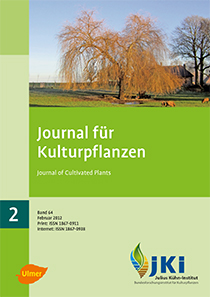Water-friendly plant protection to conserve grown orchard landscapes in Germany
DOI:
https://doi.org/10.5073/JfK.2012.02.01Keywords:
Water-friendly plant protection, fruit growing, drift reducing techniques, spray deposits/depositions, Recycling/rate of saved plant protection products, biological efficiency, operational assessment, spraying spots, water body monitoringAbstract
The FuE project aimed at testing new techniques to reduce drift in orchards of the Alten Landes (NS) and the fruit growing area around Lake Constance (BW), and assess their suitability as to water-friendly plant protection by accompanying examinations.
The sprayers used in NS were dominated by a double row, overarching mode of operation, whereas the sprayers in BW were designed for single row treatment because of the extensive spread of hail protection nets. In both growing areas a technically identical sprayer with axial flow fan for single row treatment (air exit outlets and sensor controlled nozzle regulation were covered) was used as reference sprayer.
The sprayers used on nine fruit farms (NS: 4, BW: 5) were equipped with the following facilities to reduce drift:
•Single and double row tunnel with re-circulation of not deposited plant protection products (recycling)
•Reflector system with integrated recycling system, which redirects the spray jet coming out of the treated row
•Fan with different air conduction, sensor controlled nozzle regulation and airflow adjustment
Testing in practice has demonstrated that single row sprayers and also double row sprayers are suited for use in regions with plenty of water.
Regarding the deposition of spray liquid in orchards it became clear that only tunnel sprayers, which are distinguished by a shielded application zone, achieve extremely even and continuously high spray deposits of approximately 20% in relation to the application rate. Single row sprayers with fan unit and electrically adjustable shields on the fan outlet generated an average of 16 to 18% of spray liquid deposits.
The drift results showed that all sprayers could achieve a drift reduction of more than 95%. Precondition would be the use of coarse, drift-reducing nozzles and the reduction of the airflow rate in the initial 5 rows close to water bodies.
Sprayers equipped with a recycling system or sensor technology bring about an additional economical benefit due to their rate of saved product. The single row tunnel sprayer was able to achieve an average reduction of approx. 50% by flexibly adjusting to row widths. The double row tunnel sprayers achieved approx. a 19% reduction on average. Sensor technology accomplished reductions of 12 to 19%.
Biological efficiency of all sprayers was sufficient. However, a certain unsteadiness cannot be entirely excluded for reflector and sensor controlled sprayers.
From an economic point of view, the single row tunnel sprayer pays already from an orchard size of 8–10 ha and is thus comparable with single row sprayers. The double row technologies are only worth the effort on coherent areas from 20 ha upwards. Their utilization was very demanding compared to single row sprayers but lead to a clout increase of approx. 80%.
Coarse nozzles created more spraying spots. This aspect is presently only relevant regarding direct marketing of products and sorting without unloading in water.
The results of water body monitoring confirmed mainly the high drift reduction of the tested recycling sprayer and of the sprayer equipped with cross flow fan and sensor technology. According to water body monitoring, the three other tested sprayers achieved a lower drift reduction rate. Water protection was not adhered to in all cases with drift reduction rates below 99%, calculated from water body monitoring.
Downloads
Published
Issue
Section
License
The content of the journal is licensed under the Creative Commons Attribution 4.0 License. Any user is free to share and adapt (remix, transform, build upon) the content as long as the original publication is attributed (authors, title, year, journal, issue, pages).
The copyright of the published work remains with the authors. The authors grant the Journal of Cultivated Plants, the Julius Kühn-Institut and the OpenAgrar repository the non-exclusive right to distribute and exploit the work.







